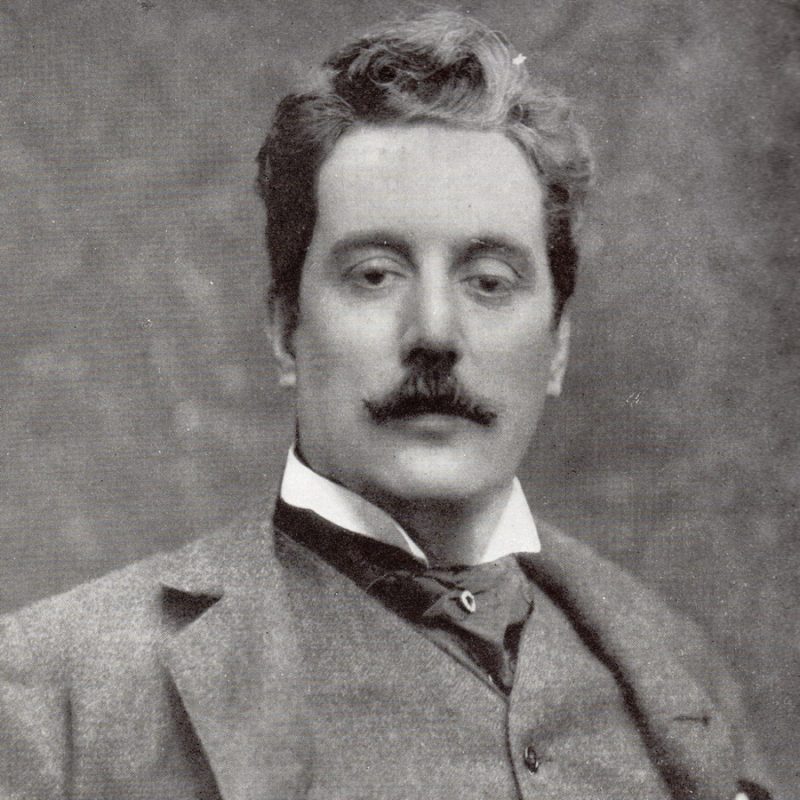
Giacomo Puccini (Giacomo Antonio Domenico Michele Secondo Maria Puccini) was born on December 22, 1858 in Lucca, Italy. He was one of the greatest exponents of operatic realism, who virtually brought the history of Italian opera to an end. His mature operas included La Bohème (1896), Tosca (1900), Madama Butterfly (1904), and Turandot (left incomplete).
Puccini was the last descendant of a family that for two centuries had provided the musical directors of the Cathedral of San Martino in Lucca. Puccini initially dedicated himself to music, therefore, not as a personal vocation but as a family profession. He was orphaned at the age of five by the death of his father, and the municipality of Lucca supported the family with a small pension and kept the position of cathedral organist open for Giacomo until he came of age. A performance of Giuseppe Verdi’s Aida, which he saw in Pisa in 1876, convinced him that his true vocation was opera. In the autumn of 1880 he went to study at the Milan Conservatory, where his principal teachers were Antonio Bazzini, a famous violinist and composer of chamber music, and Amilcare Ponchielli.
After the death of his mother, Puccini fled from Lucca with a married woman, Elvira Gemignani. Finding in their passion the courage to defy the truly enormous scandal generated by their illegal union, they lived at first in Monza, near Milan, where a son, Antonio, was born. In 1890 they moved to Milan, and in 1891 to Torre del Lago, a fishing village on Lake Massaciuccoli in Tuscany.
Puccini returned from Bayreuth with the plan for Manon Lescaut, based, like the Manon of the French composer Jules Massenet, on the celebrated 18th-century novel by the Abbé Prévost. Beginning with this opera, Puccini carefully selected the subjects for his operas and spent considerable time on the preparation of the librettos. The psychology of the heroine in Manon Lescaut, as in succeeding works, dominates the dramatic nature of Puccini’s operas. Puccini, in sympathy with his public, was writing to move them so as to assure his success. The score of Manon Lescaut, dramatically alive, prefigures the operatic refinements achieved in his mature operas: La Bohème, Tosca, Madama Butterfly, and La fanciulla del west (1910; The Girl of the Golden West). These four mature works also tell a moving love story, one that centers entirely on the feminine protagonist and ends in a tragic resolution.
The premiere of La fanciulla del west took place at the Metropolitan Opera in New York City on December 10, 1910, with Arturo Toscanini conducting. It was a great triumph, and with it Puccini reached the end of his mature period. He admitted “writing an opera is difficult.” For one who had been the typical operatic representative of the turn of the century, he felt the new century advancing ruthlessly with problems no longer his own. He did not understand contemporary events, such as World War I. In 1917 at Monte-Carlo in Monaco, Puccini’s opera La rondine was first performed and then was quickly forgotten.
His last opera, based on the fable of Turandot as told in the play Turandot by the 18th-century Italian dramatist Carlo Gozzi, is the only Italian opera in the Impressionistic style. Puccini did not complete Turandot, unable to write a final grand duet on the triumphant love between Turandot and Calaf. Suffering from cancer of the throat, he was ordered to Brussels for surgery, and a few days afterward he died with the incomplete score of Turandot in his hands.
Turandot was performed posthumously at La Scala on April 25, 1926, and Arturo Toscanini, who conducted the performance, concluded the opera at the point Puccini had reached before dying. Two final scenes were completed by Franco Alfano from Puccini’s sketches.
Solemn funeral services were held for Puccini at La Scala in Milan, and his body was taken to Torre del Lago, which became the Puccini Pantheon. Shortly afterward, Elvira and Antonio were also buried there. The Puccini house became a museum and an archive.
The main feature of Puccini’s musicodramatic style is his ability to identify himself with his subject; each opera has its distinctive ambiance. With an unfailing instinct for balanced dramatic structure, Puccini knew that an opera is not all action, movement, and conflict; it must also contain moments of repose, contemplation, and lyricism. For such moments he invented an original type of melody, passionate and radiant, yet marked by an underlying morbidity; examples are the “farewell” and “death” arias that also reflect the persistent melancholy from which he suffered in his personal life.
Puccini’s conception of diatonic melody is rooted in the tradition of 19th-century Italian opera, but his harmonic and orchestral style indicate that he was also aware of contemporary developments, notably the work of the Impressionists and of Stravinsky. Though he allowed the orchestra a more active role, he upheld the traditional vocal style of Italian opera, in which the singers carry the burden of the music. In many ways a typical fin de siècle artist, Puccini nevertheless can be ranked as the greatest exponent of operatic realism.


